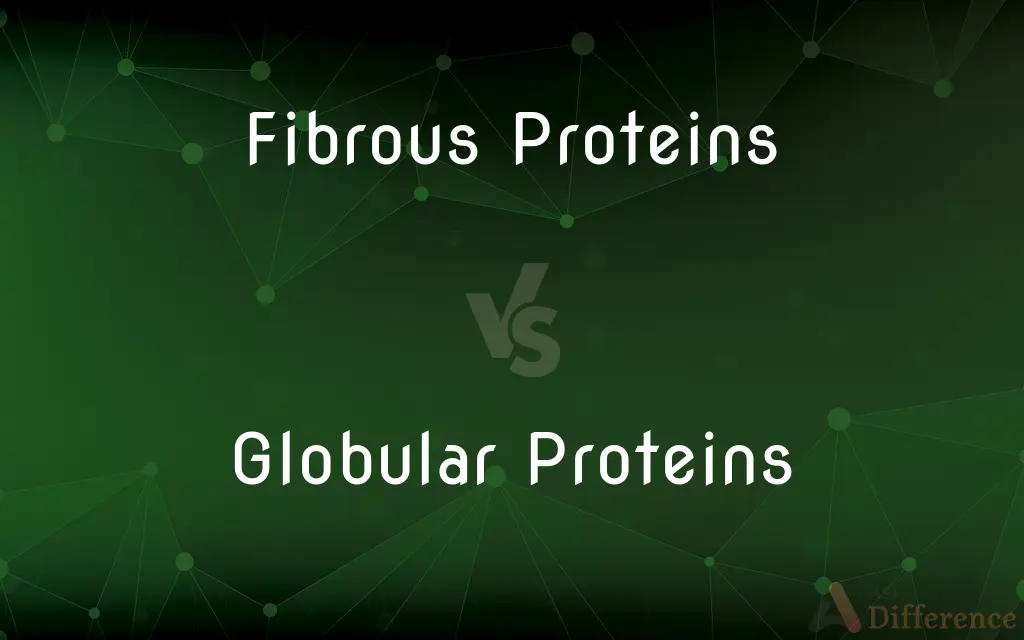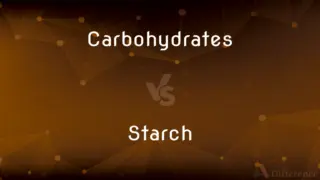Fibrous Proteins vs. Globular Proteins — What's the Difference?
By Tayyaba Rehman — Published on January 14, 2024
Fibrous proteins are elongated, structural proteins, while globular proteins are spherical, functional proteins.

Difference Between Fibrous Proteins and Globular Proteins
Table of Contents
ADVERTISEMENT
Key Differences
Fibrous proteins are characterized by elongated, thread-like structures. Globular proteins, on the other hand, have spherical, compact shapes.
Fibrous proteins primarily provide structural support in organisms. In contrast, globular proteins are more involved in functional roles such as catalysis, transport, and regulation.
The solubility of fibrous proteins in water is generally low. Globular proteins are typically soluble in water, making them vital for various biochemical processes.
Fibrous proteins exhibit repeating amino acid sequences, providing strength and durability. Globular proteins have varied amino acid sequences, allowing for diverse functionality.
The secondary structure of fibrous proteins is often dominated by a single type, like alpha-helix or beta-sheet. Globular proteins display a complex mix of secondary structures within their compact form.
ADVERTISEMENT
Comparison Chart
Shape
Elongated, thread-like.
Spherical, compact.
Role
Structural support.
Functional, such as enzymes and antibodies.
Solubility
Generally water-insoluble.
Typically water-soluble.
Amino Acid Sequence
Repetitive sequences.
Varied sequences.
Secondary Structure
Often a single type (e.g., alpha-helix).
Mix of structures (alpha-helix, beta-sheet).
Compare with Definitions
Fibrous Proteins
Provides support in organisms.
Collagen, a fibrous protein, strengthens skin and bones.
Globular Proteins
Displays diverse amino acid patterns.
Albumin, a globular protein, has various functions.
Fibrous Proteins
Often not soluble in water.
Fibrous proteins in wool make it water-resistant.
Globular Proteins
Involved in various body functions.
Hemoglobin, a globular protein, carries oxygen in blood.
Fibrous Proteins
Has repeating amino acid patterns.
Elastin, a fibrous protein, gives elasticity to tissues.
Globular Proteins
Typically soluble in water.
Antibodies, globular proteins, are soluble in blood.
Fibrous Proteins
Characterized by a long structure.
Keratin, a fibrous protein, forms hair and nails.
Globular Proteins
Compact and rounded structure.
Enzymes, globular proteins, catalyze reactions.
Fibrous Proteins
Contributes to the strength of tissues.
Fibrous proteins in tendons withstand force.
Globular Proteins
Performs a range of functions.
Hormones, globular proteins, regulate bodily processes.
Common Curiosities
Where are Fibrous Proteins found?
In connective tissues, hair, and nails.
What are Fibrous Proteins?
Elongated proteins providing structural support.
Are Fibrous Proteins water-soluble?
Generally, they are water-insoluble.
What roles do Globular Proteins play?
Roles in catalysis, transport, and immune response.
Can Globular Proteins be enzymes?
Yes, many enzymes are globular proteins.
What's a common example of a Globular Protein?
Hemoglobin in red blood cells.
Can Fibrous Proteins form fibers?
Yes, they can aggregate into fibers.
What are Globular Proteins?
Spherical proteins involved in various functions.
What's the solubility difference between the two?
Fibrous proteins are less soluble in water compared to globular proteins.
Do Fibrous Proteins have a repetitive structure?
Yes, they often have repeating amino acid sequences.
Is Insulin a Globular Protein?
Yes, it's a hormone and a globular protein.
Are Fibrous Proteins involved in movement?
They mostly provide support, not movement.
How do Globular Proteins affect metabolism?
They act as enzymes, regulating metabolic pathways.
Do Globular Proteins have a complex structure?
Yes, they have complex, diverse structures.
Is Collagen a Fibrous Protein?
Yes, it's a primary fibrous protein in connective tissues.
Share Your Discovery

Previous Comparison
Cohesion vs. Coherence
Next Comparison
Carbohydrates vs. StarchAuthor Spotlight
Written by
Tayyaba RehmanTayyaba Rehman is a distinguished writer, currently serving as a primary contributor to askdifference.com. As a researcher in semantics and etymology, Tayyaba's passion for the complexity of languages and their distinctions has found a perfect home on the platform. Tayyaba delves into the intricacies of language, distinguishing between commonly confused words and phrases, thereby providing clarity for readers worldwide.
















































